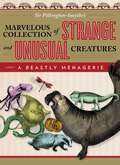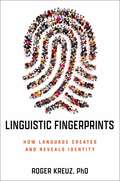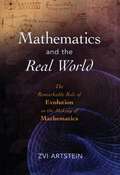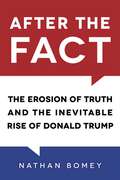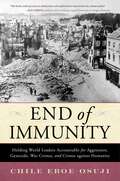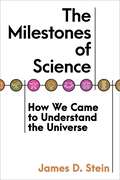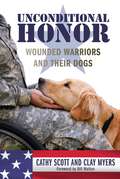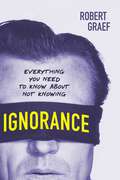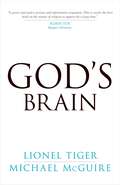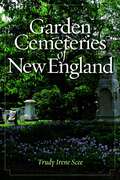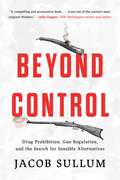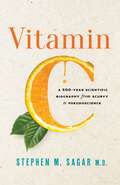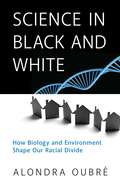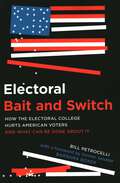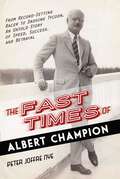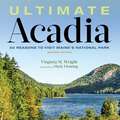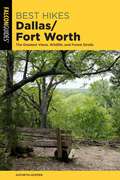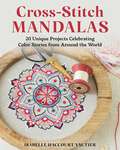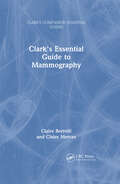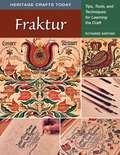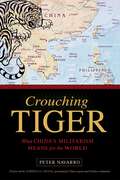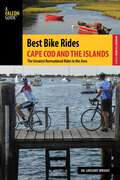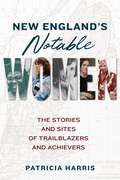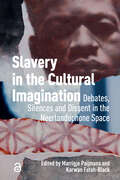- Table View
- List View
Beastly Menagerie: Sir Pilkington-Smythe's Marvelous Collection Of Strange And Unusual Creatures
by Sir Pilkington-SmytheA modern-day bestiary of the most incredible animals the world has ever seen—with 200 full-color illustrationsOur planet is a writhing mass of wondrous life, positively popping at the seams with peculiar creatures. Life has wriggled its way into every conceivable nook and cranny, and nature has belched out organisms into even the most inhospitable environments.A Beastly Menagerie is a compendium of 100 of these most curious of creatures, from beasts that can fit on a pinhead and survive a saunter into space, to sea creatures just waiting for an excuse to smash a ship to smithereens. And let's not forget to mention the remarkable Jesus Christ lizard, the bone-eating snot flower, the pink fairy armadillo, and the zombie fly.This beautifully illustrated collection will delight and bedazzle fans of the amazing animal kingdom in equal measure. Narrated by the affable eccentric Sir Pilkington-Smythe and assisted by his cronies at The Proceedings of the Ever So Strange, each entry is an enlightening and marvelous foray into our world and all its wonders . . . topped off with a soupçon of silliness.An excerptSharks are pretty pleased with themselves, and so they should be. You see, they are basically rippling slabs of muscle in gunmetal grey, with row upon row of huge razor-sharp teeth—awesome eating machines that have remained unchanged for millennia. . . . Of course, some sharks don't look so tough. Think of the bizarre hammerhead, goblin, and frilled sharks. Not that they're to be trifled with. And then there's the cookie cutter shark, a sniveling little guttersnipe who looks more like a fat lady's arm holding a kitchen utensil than the pinnacle of predatory evolution.
Linguistic Fingerprints: How Language Creates and Reveals Identity
by Roger KreuzHow much of ourselves do we disclose when we speak or write? A person&’s accent may reveal, for example, whether they hail from Australia, or Ireland, or Mississippi. But it&’s not just where we were born—we divulge all sorts of information about ourselves and our identity through language. Level of education, gender, age, and even aspects of our personality can all be reliably determined by our vocabulary and grammar. To those who know what to look for, we give ourselves away every time we open our mouths or tap on a keyboard.But how unique is a person&’s linguistic identity? Can language be used to identify a specific person? To identify—or to exonerate—a murder suspect? To determine who authored a particular book? The answer to all these questions is yes. Forensic and computational linguists have developed methods that allow linguistic fingerprinting to be used in law enforcement. Similar techniques are used by literary scholars to identify the authors of anonymous or contested works of literature. Many people have heard that linguistic analysis helped to catch the Unabomber, or to unmask an anonymous editorialist—but how is it done? LINGUSISTIC FINGERPRINTS will explain how these methods were developed and how they are used to solve forensic and literary mysteries. But these techniques aren&’t perfect, and the book will also include some cautionary tales about mistaken linguistic identity.
Mathematics and the Real World: The Remarkable Role of Evolution in the Making of Mathematics
by Zvi ArtsteinIn this accessible and illuminating study of how the science of mathematics developed, a veteran math researcher and educator looks at the ways in which our evolutionary makeup is both a help and a hindrance to the study of math. Artstein chronicles the discovery of important mathematical connections between mathematics and the real world from ancient times to the present. The author then describes some of the contemporary applications of mathematics-in probability theory, in the study of human behavior, and in combination with computers, which give mathematics unprecedented power. The author concludes with an insightful discussion of why mathematics, for most people, is so frustrating. He argues that the rigorous logical structure of math goes against the grain of our predisposed ways of thinking as shaped by evolution, presumably because the talent needed to cope with logical mathematics gave the human race as a whole no evolutionary advantage. With this in mind, he offers ways to overcome these innate impediments in the teaching of math.
After the Fact: The Erosion of Truth and the Inevitable Rise of Donald Trump
by Nathan BomeyThis trenchant analysis examines the many ways our society's increasingly tenuous commitment to facts laid the groundwork for Donald Trump's rise to power. Award-winning journalist Nathan Bomey argues that Trump did not usher the post-truth era into being. He was its inevitable outcome. Bomey points to recent trends that have created the perfect seedbed for spin, distortion, deception, and bald-faced lies: shifting news habits, the rise of social media, the spread of entrenched ideologies, and the failure of schools to teach basic critical-thinking skills The evidence supporting the author's argument is all around us: On Facebook, we present images of our lives that ignore the truth and intentionally deceive our friends and family. We consume fake news stories online and carelessly circulate false rumors. In politics, we vote for leaders who leverage political narratives that favor ideology over science. And in our schools, we fail to teach students how to authenticate information. After the Fact explores how the convergence of technology, politics, and media has ushered in the misinformation age, sidelining the truth and threatening our core principle of community.
End of Immunity: Holding World Leaders Accountable for Aggression, Genocide, War Crimes, and Crimes against Humanity
by Chile Eboe-OsujiRussia&’s invasion of Ukraine in 2022 has shown the world the critical importance of whether and how to punish heads of state, heads of government, and sundry strong men when accused of crimes of aggression, genocide, war crimes, and other crimes against humanity. In End of Immunity, former President of the International Criminal Court, Chile Eboe-Osuji, probes the history and theory of the concept of immunity for heads of state, underscoring tribunal achievements, pointing out gaps in the existing framework of accountability and the hypocrisies that produced them, and offering workable solutions to the loopholes that government leaders still use to escape consequences today.Eboe-Osuji traces the development of international law from the pre-World War I era that left wars of aggression as the prerogative of sovereigns able to wage them through the peacetime conferences of the Hague at the turn of the 20th century, the momentous Article 227 of the Versailles Peace Treaty of 1919, which communicated the resolve of the Allies and Associated Powers to prosecute German Emperor and King of Prussia Kaiser Wilhelm II before an international tribunal, how the legal norms applied in the post-WWII Nuremberg trial transformed the norms of modern international law, how 1990&’s Africa breathed new life into arguments against immunity for heads of state, and how modern-day Russia flouts those laws with Putin&’s war of aggression on Ukraine. Going as far back as the Middle Ages and the ancient doctrine of the divine right of kings, and concluding with a fresh new proposal for the ways in which international law can be shored up to prosecute those leaders who wage wars of aggression, Eboe-Osuji investigates the journey of international law&’s rejection of immunity for anyone – including heads of state in particular – when they are suspected or accused of atrocities that international law has proscribed as crimes. The result is the definitive account of a profoundly vital principle for international relations and global humanity.
The Milestones of Science: How We Came to Understand the Universe
by James D. SteinIf we were to judge humanity&’s greatest accomplishments, science is almost certainly at the top of the list. The Milestones of Science is a collection of the most important and impressive breakthroughs in the history of science – as well as the scientists behind him – from the ancient world to what the future of science may hold. Comprised of riveting and readable stories from along the path of scientific discovery in the fields of Astronomy, The Earth, Matter, Forces and Energy, Chemistry, Life, Genetics & DNA, The Human Body, Disease, and Science in the 21st Century, author James D. Stein showcases the most noteworthy achievements of our species in a compelling and comprehensive way. The Milestones of Science highlights key observations, experiments, luminaries, and theories including:The Astronomical work of Galileo, Newton, and EinsteinBlack Holes, Quasars, and PulsarsThe Theory of Plate TectonicsLord Kelvin&’s theory of The Age of the EarthPlanck&’s Quantum HypothesisFaraday, Maxwell, and the Theory of ElectromagnetismMendeleyev and The Periodic Table of ElementsDarwin, Wallace, and the Theory of EvolutionLouis Pasteur and The Germ TheoryThe modern discovery of the Higgs Boson particle… and many more. Concluding with a chapter that describes how the internet has changed the process of doing science in the twenty-first century, this essential book covers not just the science, but the people whose life work helps us better understand the world around us.
Unconditional Honor: Wounded Warriors and Their Dogs
by Cathy ScottIn this comprehensive and gorgeously illustrated book, Cathy Scott and Clay Myers show how service and therapy dogs are having a profound impact on the lives of military personnel injured in action. Not only do our veterans deal with physical injuries, but they often return with psychological issues that can be treated with help, companionship, and love from working canines. Through moving stories and color photographs, Unconditional Honor highlights the nearly forty-year history of working dogs helping wounded veterans, the mental and physical combat traumas that are mitigated by the dogs, the selection and training of the dogs, including rescued canines, and what the future holds. Featured in the book are inspiring personal accounts of what the dogs mean to veterans, and how their lives have been forever changed and even saved since adopting canines. In addition to the remarkable healing journeys of wounded warriors and their canines, this book showcases the various groups, formed originally to train dogs for the blind and the physically disabled that now embrace military services, that provide, at no cost, returning troops with dogs to make them whole again after surviving the reality of war.
Ignorance: Everything You Need to Know about Not Knowing
by Robert GraefSums up the many fields of study where ignorance can undermine our understanding, while showing how an awareness of ignorance can lead to exploration and the discovery of new knowledge. The flip side of knowledge is ignorance. This book explores the vast scope of ignorance, even in an age when we think we know more than ever before. By marking off this ocean of ignorance into manageable categories, the author provides a kind of navigational chart to the unknown, and a series of red flags to all those who claim certitude. The book first lays out the many branches of ignorance—in education, the media, politics, religion, science, and other major institutions. It then assesses the costs and consequences of that ignorance. World conflicts, endemic poverty, environmental damage, waste, racism, and the manipulative forces of industry and politics that use propaganda to manipulate the public may all be seen as rooted in ignorance. But there are positive aspects of ignorance as well. Scientists and artists, by recognizing what they don't know, are spurred on to new creative approaches and discoveries, which would never be found by those too comfortable with the tried and true. The author cites Socrates, whom the Delphic Oracle declared to be the wisest of all people simply because he realized how much he didn't know. This book gives you ways to follow in the path that Socrates forged, to counter the closed minds whose false sense of certainty cannot help but distort reality, and to be better prepared to take on even the most serious challenges of today.
God's Brain
by Lionel Tiger Michael McGuireIn the fractious debate on the existence of God and the nature of religion, two distinguished authors radically alter the discussion. Taking a perspective rooted in evolutionary biology with a focus on brain science, the authors elucidate the perennial questions about religion: What is its purpose? How did it arise? What is its source? Why does every known culture have some form of it? Their answer is deceptively simple, yet at the same time highly complex: The brain creates religion and its varied concepts of God, and then in turn feeds on its creation to satisfy innate neurological and associated social needs. Brain science reveals that humans and other primates alike are afflicted by unavoidable sources of stress that the authors describe as "brainpain." To cope with this affliction people seek to "brainsoothe." We humans use religion and its social structures to induce brainsoothing as a relief for innate anxiety. How we do this is the subject of this groundbreaking book. In a concise, lively, accessible, and witty style, the authors combine zoom-lens vignettes of religious practices with discussions of the latest research on religion's neurological effects on the brain. Among other topics, they consider religion's role in providing positive socialization, its seeming obsession with regulating sex, creating an afterlife, how religion's rules of behavior influence the law, the common biological scaffolding between nonhuman primates and humans and how this affects religion, a detailed look at brain chemistry and how it changes as a result of stress, and evidence that the palliative effects of religion on brain chemistry is not matched by nonreligious remedies. Concluding with a checklist offering readers a means to compute their own "brainsoothe score," this fascinating book provides key insights into the complexities of our brain and the role of religion, perhaps its most remarkable creation.
Garden Cemeteries of New England
by Trudy Irene SceeIn 1831 a new entity appeared on the American landscape: the garden cemetery. Meant to be places where the living could enjoy peace, tranquility and beauty, as well as to provide a final resting place for the dead, the garden cemeteries would forever change the culture of death and burial in the United States. The ideal cemetery would become one in which ornamental trees, bushes, flowers, and waterways graced the ever more artistic (for those who could afford them) monuments to the dead. Previous to the 1830s, the deceased were buried in church lots, in small and soon overcrowded public lots, and even, occasionally in backyards and fields. Graves were often untended, weeds and decay soon took over, and the frequently used wooden grave markers rotted away. Some turned to a movement emerging in Europe, in which horticulture was starting to become a factor in cemetery planning, at a time in which cemetery planning itself was a novel idea. New England was the first region in America to take up the new ideals.The first such cemetery, Mt. Auburn, opened in Cambridge, Massachusetts, in 1831, and Mount Hope Cemetery, in Bangor, Maine, followed in 1834. Today, these cemeteries are both beautiful places to visit and important historical sites. The author takes readers on a historical tour of eighteen of the Northeast's garden cemeteries, exploring the landscape architecture, the stunning beauty, and delving into the rich history of both the sites and of those who are buried there.
Orvis Guide to Family Friendly Fly Fishing (Orvis)
by Tom RosenbauerThe Orvis Book of Family Friendly Fly FishingLike all sports, the fun of fly-fishing lies in sharing the experience and in spending time with those closest to you. And yet for a father unsure how to connect with his bored, PlayStation-dazed kids, for a beginning fisherman who doesn’t want to learn casting techniques by himself, for a mother who would love to show her children the outdoors but isn’t quite sure how to begin, it can be a frustrating and intimidating business.From one of the most trusted brands in the industry, and from one of the sport’s most esteemed authors, The Orvis Guide to Family-Friendly Fly-Fishing by Tom Rosenbauer will take the mystery out of sharing the experience.Rosenbauerprovides instructional guidance, discusses the nuts and bolts of casting, fly choice, and technique, and opens the lens to discuss family-friendly destinations, gear, schools, safety, and more.Rosenbauer brings his expertise to bear on perhaps the most essential skill set of all—introducing the people closest to you to your beloved sport.Tom Rosenbauer, host of the Orvis Fly Fishing Podcasts, has been with the Orvis Company over 30 years. Rosenbauer is Fly Rod & Reel magazine's 2011 Angler of the Year and author of The Orvis Fly-Fishing Guide, one of the best-selling fly-fishing books ever.
Beyond Control: Drug Prohibition, Gun Regulation, and the Search for Sensible Alternatives
by Jacob SullumIn this incisive book, Reason editor Jacob Sullum untangles America&’s twin crusades against guns and drugs, suggesting better-tailored alternatives that do more good while causing less harm. Does gun control work? What about drug prohibition? In this cogent examination of two of America&’s most enduring challenges, Reason Senior Editor Jacob Sullum traces the evolution of gun and drug laws from their dubious beginnings to today&’s divisive rhetoric. Based on data-driven analysis and compassionate consideration of the human costs imposed by the twin crusades against guns and drugs, Sullum recommends an alternative approach that focuses on reducing harm, including the harm caused by misguided policies. Sullum exposes the racist roots of gun control and drug control, noting that both policies continue to have a racially disproportionate impact. Even leaving aside the legacy of that dark history, he argues, both policies are unjust because they punish people for conduct that violates no one&’s rights. They are also dangerous to civil liberties because they encourage the expansion of government power at the expense of individual freedom. The burdens imposed by gun control and drug control reinforce each other, since gun possession increases penalties for drug offenses and drug offenses disqualify people from legally possessing guns. Yet there is little logic to these legal regimes, which penalize people for behavior that is not inherently criminal. Decades of research have produced scant evidence that popular gun control prescriptions such as assault weapon bans, universal background checks, restrictions on ownership, and red flag laws work as advertised. Research on the impact of the war on drugs likewise provides little reason to believe that its doubtful benefits outweigh its myriad costs. In both cases, the burdens often fall on peaceful individuals who pose no threat to public safety, and the policies seem ill-designed to reduce the problems they aim to address. Sullum notes that critics of gun control and critics of the war on drugs make similar points, complaining that these policies are unfair, invasive, poorly targeted, and ineffective. But because these two sets of critics tend to come from opposing political camps, they usually overlook their common ground. Beyond Control surveys that territory, showing that conservatives and progressive share concerns about overcriminalization, overzealous law enforcement, draconian penalties, and the erosion of civil liberties. Substance abuse, violence, and suicide are complex problems that cannot be solved by targeting inanimate objects or by arresting and incarcerating people who possess them. Beyond Control urges better-tailored alternatives that would do more good while causing less harm.
Vitamin C: A 500-Year Scientific Biography from Scurvy to Pseudoscience
by Stephen M. Sagar M.D.Vitamin C: A 500-Year Scientific Biography from Scurvy to Pseudoscience is the compelling story of the history and science behind vitamin C.Vitamin C begins with scurvy, which afflicted Europe for four hundred years and killed millions. The reasons that a disease whose cure was known from the outset persisted over that time are at once baffling and familiar, and these trials eventually lead to invention of the science of epidemiology. Author Stephen M. Sagar MD then chronicles the discovery of vitamins at the beginning of the twentieth century, a story that encapsulates the rise of a scientific approach to nutrition but with surprising twists and turns. As vitamin science became more acquainted with the mainstream, scientist Linus Pauling reached new heights of fame and influence by popularizing the practice of taking megadoses of vitamin C to prevent colds – a claim that was not necessarily backed by data. This kickstarted the growth of the $40 billion vitamin and supplement industry, which has since prospered all while ignoring science. This unique and engrossing narrative reveals how medical science functions in the real world and how it has changed over the centuries. Featuring swashbuckling sailors, arctic explorers, penny-pinching bureaucrats, academicians with clashing egos, and intrepid scientists working in malaria-infested jungle laboratories, the story of C is in many ways the story of how science gets done (and undone). From the trial and error of early explorers to the scientific breakthroughs made by biochemists and the birth of the modern supplement industry, this revelatory book tells the story of how cherished beliefs, self-interest, and politics often intertwine with scientific progress.
Science in Black and White: How Biology and Environment Shape Our Racial Divide
by Alondra OubreThis unflinching expose of racially biased research--the Alt-Right's "scientific wing"--debunks both old and emerging claims of inborn racial disparities.Racial groups differ in some of their social patterns, but the cause of those differences--nature versus nurture, or genetics versus environment-- remains fiercely debated. For the pro-nature camp-- sometimes aligned with white nationalism and eugenics, and often used to promote ideas of racial inferiority and superiority -- race-based biological determinism contributes significantly to the ethnic divide, especially the black/white gap in societal achievement. By contrast, pro-nurture supporters attribute ethnic variation in social outcomes primarily to environmental circumstances, ecological conditions, and personal experience. In this thoroughly researched book, science writer Alondra Oubre examines emerging scientific discoveries that show how both biology and environment interact to influence IQ--intelligence performance--and social behaviors across continental populations, or human races. She presents compelling evidence for why environmental and certain non-DNA-related biological phenomena overall seem to best explain black/white disparities in a gamut of social behaviors, including family structure, parenting, educational attainment, and rates of violent crime. As she demonstrates, nature still matters, but the biology that impacts racial variance in social behaviors extends beyond genetics to include other processes--epigenetics, gene expression, and plasticity--all of which are profoundly affected by a wide array of environmental forces. The complex, synergistic interplay of these factors combined, rather than just genes or just environment, appears to account for black/white divergence in a gamut of social behaviors.
Electoral Bait and Switch: How the Electoral College Hurts American Voters and What Can Be Done about It
by Bill PetrocelliIt&’s a system that now fosters massive inequality in voting rights and opens the door to manipulation of presidential elections by foreign and domestic enemies of democracy. Electoral Bait & Switch is prescriptive, and accessible to the general reader.The current Electoral-Vote system presents a severe and growing threat to democracy in the United States. It has thwarted the will of a majority of the voters twice in the last five presidential elections (2000 and 2016) by elevating to office a candidate who received only a minority of the vote. This system is a distortion of the system envisioned by Alexander Hamilton, James Madison and the other framers of the Constitution. If it is not challenged and overturned, we are likely to face a continual series of electoral and constitutional crises.The constitutional right of Americans to an equal vote in presidential elections is being violated by this system on a massive scale. The value of an individual vote varies as much as three-to-one from state to state, and there are no two states where voters have the same voting-power. The current Elector system discriminates heavily against minority and poorer voters. The winner-take-all method of allocating Electoral votes also results in large pockets of &“useless votes&” and a system in which where you vote counts for far more than how you vote. Most ominously, evidence is now clear that the Electoral-Vote system has opened the door for voter suppression and manipulation of elections by domestic and foreign conspirators.
The Fast Times of Albert Champion: From Record-Setting Racer to Dashing Tycoon, An Untold Story of Speed, Success, and Betrayal
by Peter Joffre NyeRACER. INNOVATOR. CELEBRITY. MOGUL. CHAMPION. This is the first biography of the short but exciting life of Albert Champion-record-setting bicyclist and motorcyclist, daredevil racecar driver, early automobile innovator, charismatic ladies' man, and celebrity of the Jazz Age. Though most Americans have heard of the companies Albert Champion founded-ACDelco and Champion Spark Plug-few know much about the charismatic man behind them.Like a Richard Branson of the early 20th century, or an Evel Knievel with a business degree, Champion was a powerhouse whose life was defined by both speed and success. Champion rose from poverty in Paris to great wealth and fame in both his native France and the United States. As a bicycle racer, Champion set more than a hundred world records. When the urban speed limit was 8 mph, he was the first ever to drive a motorcycle a mile under a minute. A car-racing crash snapped a leg bone that kept him in traction for eleven weeks. Undeterred, he hobbled out of the hospital on crutches and recovered to win the French national cycling championship. Champion invested his prize money to become a tycoon in the new and revolutionary American auto industry, working closely with the leading players and amassing thirty US. His contemporaries included Charles Lindbergh, who endorsed Champion's product by saying, "AC Spark Plugs kept my engine running perfectly."; Louis Chevrolet, whom Champion backed financially until it came out that he was trying to seduce Chevrolet's wife, which led to a fight and the end of their friendship; and William Durant, founder of a "new holding company" called General Motors. A notorious ladies' man, Champion's many dalliances were fodder for the papers and finally ended in a love triangle that resulted in his death under mysterious circumstances.
Ultimate Acadia: 50 Reasons to Visit Maine's National Park
by Virginia M. WrightUltimate Acadia is the essential book about Maine's Mount Desert Island, providing everything you need to know to make the most of your time there. Thoroughly revised and updated, the book is compiled as a kind of bucket list, suggesting 50 things to do and see to make the absolute most of your time in Acadia National Park, Bar Harbor, and the surrounding villages and environs. It includes history, natural history, geology, profiles of prominent and popular institutions, and loads of useful insider information. This fun, accessible guide is the book to buy before you go to Acadia, and the book to take with you when you leave.
Best Hikes Dallas/Fort Worth: The Greatest Views, Wildlife, and Forest Strolls (Best Hikes Near Series)
by Kathryn HopperWho says you have to travel far from home to go on a great hike? In Best Hikes Dallas and Forth Worth author Kathryn Hopper details the best hikes within an hour's drive of the greater Dallas and Fort Worth area perfect for the urban and suburbanite hard-pressed to find great outdoor activities close to home. Each featured hike includes detailed hike specs, a brief hike description, trailhead location, directional cues, and a detailed map.
Cross-Stitch Mandalas: 20 Unique Projects Celebrating Color Stories from Around the World
by Isabelle Haccourt VautierImmerse yourself in serenity with 20 stunning mandalas for cross-stitch, each inspired by global destinations, blending intricate designs with color symbolism to create beautiful, calming art for your home!Mandalas are intricate circular designs used around the world to invoke calm through reflection. In recent times, drawing, coloring, and painting mandalas have become popular ways to seek out this inner serenity. It is in this spirit that the talented embroiderer Isabelle Haccourt Vautier offers 20 mandalas inspired by cities and countries she dreams of visiting. Using her imagination and knowledge of the places&’ histories and traditions, she has created breathtaking mandalas that celebrate the spirit of each destination.Completed pieces are shown finished in a variety of ways: wall hangings and banners, pouches and totes, pincushions, tea towels, and more. Each design includes a list of fabrics and embroidery floss colors used and detailed cross-stitch charts. Both stitching and admiring these stunning mandalas will transport you to a place of calm and joy!
Clark's Essential Guide to Mammography (Clark's Companion Essential Guides)
by Claire Mercer Claire BorrelliThis easy-to-understand pocketbook in the highly respected Clark’s stable of imaging texts is an invaluable tool and training aid, providing essential information for mammographic positioning, technique and interpretation for mammography practitioners at all levels.Adopting a systematic and structured approach facilitating rapid reference in the clinical setting, the book covers general principles and all routine mammographic projections, including additional and adapted projections covered in a separate section, and is highly illustrated with clear explanatory line diagrams and imaging photographs.Clark’s Essential Guide to Mammography is ideal as an educational tool for trainee mammographers, trainee assistant and associate apprenticeship mammographers, mammography training teams and universities delivering mammography education and a convenient clinical guide for practising mammographers, including assistant and associate apprenticeship mammographers.
Fraktur: Tips, Tools, and Techniques for Learning the Craft
by Ruthanne HartungThe Pennsylvania Dutch are noted for the beautifully designed and hand-lettered documents known as fraktur. These include birth and marriage certificates, family trees, bookplates, awards, and house blessings. Leading fraktur artist Ruthanne Hartung adapts the craft to modern tastes and needs in this practical how-to book, with information on tools, step-by-step instructions, ideas for design, lettering and coloring techniques, and a variety of projects. An assortment of traditional patterns to apply to personal frakturs are included.
Crouching Tiger: What China's Militarism Means for the World
by Peter NavarroWill there be war with China? This book provides the most complete and accurate assessment of the probability of conflict between the United States and the rising Asian superpower. Equally important, it lays out an in-depth analysis of the possible pathways to peace. Written like a geopolitical detective story, the narrative encourages reader interaction by starting each chapter with an intriguing question that often challenges conventional wisdom. Based on interviews with more than thirty top experts, the author highlights a number of disturbing facts about China's recent military buildup and the shifting balance of power in Asia: the Chinese are deploying game-changing "carrier killer" ballistic missiles; some of America's supposed allies in Europe and Asia are selling highly lethal weapons systems to China in a perverse twist on globalization; and, on the U.S. side, debilitating cutbacks in the military budget send a message to the world that America is not serious about its "pivot to Asia." In the face of these threatening developments, the book stresses the importance of maintaining US military strength and preparedness and strengthening alliances, while warning against a complacent optimism that relies on economic engagement, negotiations, and nuclear deterrence to ensure peace. Accessible to readers from all walks of life, this multidisciplinary work blends geopolitics, economics, history, international relations, military doctrine, and political science to provide a better understanding of one of the most vexing problems facing the world.
Best Bike Rides Cape Cod and the Islands: The Greatest Recreational Rides in the Area (Best Bike Rides Series)
by Gregory WrightBest Bike Rides Cape Cod and the Islands describes 40 of the greatest recreational rides in the Cape Cod area. Road rides, rail trails, bike paths, and single-track mountain bike rides all get included. Most rides are in the 5- to 35-mile range, allowing for great afternoon outings and family adventures. Best Bike Rides Cape Cod and the Islands includes a map of each ride, a log of significant milepoints, a text description of the ride, a start-finish point with nearby motor vehicle parking, the GPS coordinates of the start-finish point, and color photos. Also included is information on local restaurants, lodging, maps, bicycle shops, other facilities for cyclists, and community resources.
New England's Notable Women: The Stories and Sites of Trailblazers and Achievers
by Patricia HarrisNew England has nurtured countless women who shook off traditional gender roles to forge their own destinies. Their achievements are legion. Narragansett tribal historian Princess Red Wing served as a delegate to the United Nations and co-founded Rhode Island&’s Tomaquag Museum. Boston iconoclast Isabella Stewart Gardner had the acute artistic vision to establish the museum that bears her name. Harriet Beecher Stowe ignited public opinion against slavery, arguably hastening the Civil War, as displays in her Hartford home make clear. Pioneering naturalist Rachel Carson jumpstarted the modern environmental movement with her writings about the rocky beaches and quivering tidepools of Southport, Maine. New England's Notable Women shines the spotlight on 45 of these trailblazers and achievers and directs readers to the homes and sites throughout New England where their stories come to life.
Slavery in the Cultural Imagination: Debates, Silences, and Dissent in the Neerlandophone Space (Slavery and Emancipation)
by Karwan Fatah-Black Marrigje PaijmansWith the rising tide of scholarly and societal interest in the history and legacy of colonialism and slavery, this collection offers a much-needed diachronic analysis of the cultural representations of the lives and afterlives of those subjected to slavery and indenture. It focuses on the history of the ‘neerlandophone’ space, defined as the complex linguistic space spanning former Dutch colonies. This collection gives a longue durée overview, with cases from the early modern period to the present day, revealing the deep roots of the colonial ‘cultural archive’. Scholars from a wide variety of disciplines demonstrate how attention to the layered and polyphonic qualities of narratives can reveal silent and disruptive voices in colonial discourse, as well as collective emotions and imaginations that have hitherto remained unrecorded in historical sources. They discuss different aesthetic, poetic, and storytelling practices, including literature, archival and legal documents, performance, architecture, photography, and philosophy, formed both in the metropolis and by enslaved and indentured peoples in the colonies.
